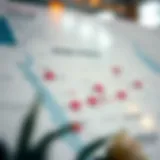Dubai Cityscape: Architecture Meets Culture
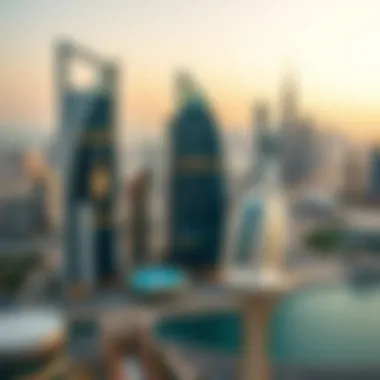

Intro
Dubai, a city where the past collides spectacularly with the present, offers an urban landscape that is nothing short of mesmerizing. One cannot help but be captivated by the juxtaposition of towering modern skyscrapers and quaint historical buildings. This bustling metropolis, located in the heart of the United Arab Emirates, has mushroomed into a global hub, attracting tourists, investors, and expats alike. The city’s architecture tells a distinct story, reflecting its aspirations, cultural influences, and innovative vision for the future.
In this article, we will delve into the intricacies of Dubai’s cityscape. We will navigate through the remarkable architectural feats that punctuate its skyline, explore the neighborhoods that give the city its character, and examine how its rich cultural heritage continues to shape its developments. Moreover, with the real estate market constantly evolving, we will provide insights tailored for investors, agents, and buyers looking to make informed decisions.
Key Highlights
- The blend of modern architecture and historical influences
- Insight into various neighborhoods and their unique attributes
- The current trends and future predictions in the property market
- Investment insights, property types, and financing options
As we embark on this exploration of Dubai’s vibrant cityscape, prepare to uncover the layers that make this city both unique and alluring. Let's pull back the curtain to see what makes Dubai tick.
Preface to Dubai's Cityscape
Dubai's cityscape is not merely a showcase of architectural prowess; it’s a vivid tapestry woven from the threads of culture, innovation, and rapid development. This blend creates a unique environment that draws not just investors, but dreamers and adventurers from around the globe. Understanding the intricacies of this urban landscape serves several purposes. It highlights the importance of visionary planning, resonates with cultural narratives, and ultimately reveals how a once-sleepy fishing village has transformed into a pivotal global hub.
Understanding Dubai's Rapid Growth
Dubai's rapid growth is nothing short of astonishing. It is a city that has expanded exponentially in just a few decades. The skyline has morphed from low-key structures to glistening skyscrapers, setting benchmarks for modern architecture worldwide. Various factors have contributed to this phenomenon:
- Economic diversification: Initially relying on oil revenues, Dubai has successfully expanded its economic portfolio to include tourism, technology, and real estate.
- Strategic location: Sitting at the crossroads of Europe, Asia, and Africa, Dubai has become an ease to access hub for international trade and travel.
- Attractive lifestyle: High living standards, luxury amenities, and anything you can think of at your fingertips, it’s a siren call for expats looking for a better life.
This blend of elements ensures that Dubai continues to be a focal point for those looking to invest or simply enjoy the enriching experiences it offers.
The Role of Urban Planning
Urban planning has played a crucial role in shaping Dubai’s formidable landscape. Rather than an ad-hoc approach, the city's planners have been savvy in their design strategies. There are a few key considerations that underscore successful urban planning in the emirate:
- Sustainability: Integrating green spaces and eco-friendly solutions is gaining traction. The municipality’s vision includes plenty of parks and sustainable initiatives to fight environmental challenges.
- Mixed-use developments: The shift toward mixed-use spaces means that residential, commercial, and recreational areas exist side by side, fostering community interaction and accessibility.
- Transportation infrastructure: The city's efforts in building a comprehensive transport system like the Dubai Metro have made commuting easier, ultimately encouraging a mobile, active population.
Each of these elements demonstrates not only foresight but a dedication to creating a robust urban environment. Urban planning remains a foundational element to cater to future growth while respecting the rich cultural fabric that gives Dubai its distinct flavor.
Architectural Innovations Shaping Dubai
As Dubai continues to establish itself as a global architectural powerhouse, the importance of architectural innovations cannot be overstated. The city is not just a canvas for bold structures; it's a testament to human ingenuity and visionary urban planning. The architectural landscape of Dubai presents a unique blend of creativity and technology. When one gazes upon its skyline, it’s clear that each iconic building tells a story of ambition and aspirations, shaping the lifestyle and experiences of those who dwell within its vicinity.
Iconic Structures and Their Significance
Burj Khalifa
Standing tall at a whopping 828 meters, the Burj Khalifa isn't merely a skyscraper; it's an architectural marvel that defines the skyline. This structure is significant for several reasons. First, it holds the title of the tallest building in the world, drawing tourists and architecture enthusiasts alike. A key characteristic of the Burj Khalifa is its sleek, tapering form, inspired by traditional Islamic architecture, which seamlessly integrates the city's modern ethos with its cultural roots.
The Burj Khalifa's presence also underscores Dubai's economic dynamism. It has become a focal point for international business and tourism, providing a glamorous backdrop for events year-round. One unique feature is the observation deck located on the 148th floor, offering breathtaking panoramic views of the city and beyond. While the cost of visiting can be a disadvantage for some, the experience is often described as once in a lifetime, making it a worthwhile investment for visitors.
Burj Al Arab
The Burj Al Arab is not just another hotel; it's a symbol of luxury and opulence, often dubbed the "world's only seven-star hotel." The structure is designed to resemble a billowing sail, standing on an artificial island, which is a notable feature of its architectural brilliance. This iconic building plays a significant role in Dubai's reputation as a luxury destination, attracting a wealthy clientele from around the globe.
Its key characteristic is the extravagant service and unparalleled amenities, which include luxurious suites, a variety of fine dining options, and exclusive access to a private beach. Although some critique its extravagant nature as excessive, it effectively showcases Dubai's commitment to luxury and hospitality.
Dubai Frame
Contrasting with the towering structures of the city, the Dubai Frame is a unique architectural feat that literally frames the Dubai skyline while serving as a bridge between the past and the present. Opened in 2018, it holds the title of the largest picture frame in the world, symbolizing the connection between Dubai's historical roots and its futuristic aspirations.
Its significance lies in the seamless blend of traditional aesthetics with cutting-edge design. The structure has a sky glass walkway, providing visitors a chance to look down at the city below, creating a thrilling experience of viewing the juxtaposition between old Dubai and the new. One could argue that its main disadvantage is the limited viewing time due to large tourist crowds, but the insights offered about Dubai’s evolution are invaluable and make it a must-see for anyone exploring the city.
Emerging Trends in Skyscraper Design
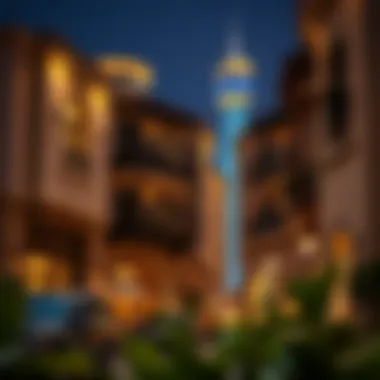

As architectural trends evolve, Dubai is at the forefront of embracing innovative designs that push the boundaries of construction and technology. Key trends include a focus on sustainability, smart buildings, and the incorporation of cultural motifs. Developers are now increasingly investing in eco-friendly materials and energy-efficient systems.
- Sustainability: Incorporating green spaces and sustainable features into designs is becoming a focal point for new projects. Buildings are now being designed with solar panels and water recycling systems integrated into their infrastructure.
- Smart Technology: The use of automation and smart technology is revolutionizing the way buildings function, improving energy efficiency and enhancing the living experience for residents and tenants.
- Cultural Integration: Many new skyscrapers reflect cultural heritage, incorporating local design elements or themes that honor Arabian architecture while shifting towards modern functionality.
In summary, the architectural innovations shaping Dubai reflect a blend of aesthetic pleasure and functional utility. Each structure is crafted with intent, drawing visitors from all corners of the globe, eager to experience the harmonious marriage of tradition and futurism that defines this extraordinary city.
Historical Context of Dubai's Urban Development
Understanding the historical context of Dubai’s urban development is fundamental to grasping the essence of its cityscape today. The city’s remarkable transformation over decades illustrates how a modest fishing village turned into a sprawling metropolis. Examining this evolution provides insight into the blend of tradition and modernity that uniquely characterizes Dubai. As investors, expats, and real estate professionals explore Dubai, they must appreciate how historical influences shape current trends and contribute to future aspirations.
From Fishing Village to Metropolis
In the early 20th century, Dubai was just a small fishing village, primarily engaged in the pearling industry. This humble beginning set the stage for the city’s later economic diversification. Wealth generated from oil discoveries in the 1960s catalyzed rapid growth, transforming what was once a serene coastal settlement into a bustling urban center.
The opening of the Dubai Creek to maritime trade allowed foreign merchants to flock to the region, further stimulating development. Buildings began to sprout, with traditional structures built of coral and limestone giving way to modern high-rises and luxury apartments.
The shift was not merely physical but also cultural. The urban landscape became a melting pot of various cultures, with Dubai serving as a bridge between East and West. Today, first-time visitors often find it hard to believe that such a global city had modest beginnings, showing just how quickly the pulse of urban life can change.
Influences of Culture and Heritage
The interplay between culture and urban development in Dubai is palpable. The government actively strives to preserve and promote the rich cultural heritage that has shaped the city’s identity. This dedication is evident in the architecture, art, and public spaces that honor the past while embracing innovation.
Traditional Architecture
Traditional architecture in Dubai holds a significant place in how the city presents itself. Characterized by wind towers, intricate plasterwork, and markets that bustled with life, these older styles serve as tangible reminders of the region’s history. The key characteristic of traditional architecture is its adaptation to the climate—using local materials and design techniques that naturally cool indoor spaces without the aid of modern air conditioning.
This makes traditional styles both a beneficial choice for cultural preservation and a popular aspect for tourists who seek a glimpse into Dubai’s storied past. A unique feature often seen in these structures is the mashrabiya, a wooden latticework that allows airflow while maintaining privacy. Its thoughtful design showcases how aesthetics can blend with functionality. The advantage of incorporating such architectural elements into modern builds is the palpable sense of history they foster amidst the skyscrapers.
Historical Landmarks
Another pillar of Dubai’s cultural footprint is its historical landmarks. Structures like the Al Fahidi Fort and the Sheikh Saeed Al Maktoum House not only serve as museums but also as vital resources for education about the emirate’s heritage.
The key characteristic of these landmarks lies in their authenticity, reflecting the lifestyle and values of the Emirati people. They provide a much-needed counterbalance to the ultramodern attractions, tipping the scale of the city’s narrative toward its roots. The unique feature of these landmarks is their ability to evoke nostalgia and pride amongst locals, serving an important role in education and tourism. Unfortunately, as the city grows at an astonishing pace, there is a risk—the potential neglect and loss of such sites in favor of newer developments.
"Understanding the past is crucial in appreciating the present as we build the future."
In summary, the historical context of Dubai’s urban development reveals an intriguing interplay of tradition and modernity. By embracing its heritage, the cityscape of Dubai stands not just as a collection of buildings but as an evolving narrative, reflecting the spirit of its people while paving the way for future growth.
Cultural Diversity Reflected in the Cityscape
Cultural diversity shapes the character of cities in profound ways. In Dubai, this melange of cultures is not just a backdrop but a vital ingredient forming the essence of urban life. Here, every street corner tells a story, and every neighborhood has its own flavor, revealing layers of social interaction and complexity. This constant interplay of varied traditions creates a rich tapestry that draws in investors, expats, agents, and buyers alike, presenting unique insights and opportunities in the real estate market.
The Mosaic of Communities
Dubai is home to a multitude of communities, making it resemble a vibrant, living mosaic. Different areas reflect different cultures— take Jumeirah, for instance, known for its luxurious residences and affluent lifestyle, a haven for wealthy expats from around the globe. Similarly, neighborhoods like Al Fahidi showcase traditional Emirati architecture, offering a glimpse into Dubai's rich past and heritage.
Key Elements of Community Diversity:
- Cultural Interactions: The daily interactions between diverse populations foster mutual respect and understanding.
- Culinary Experiences: From street food stalls to gourmet restaurants, each cuisine reflects the culture of the respective community, encouraging culinary explorers to expand their palates.
- Festivals and Celebrations: Festivals such as Diwali, Eid, and Christmas are celebrated openly, emphasizing the city’s respect for all customs and traditions.
This confluence of cultures not only enhances the livability of Dubai but also appeals to those looking to invest in the real estate sector. The city provides a unique environment for cultural exchanges which can lead to intriguing opportunities for residential and commercial properties.
Cultural Events and Their Impact on Urban Life
Cultural events in Dubai serve as vital moments for community engagement and economic stimulation. These gatherings range from art exhibitions, like Art Dubai, to music festivals such as DXB Music Festival, capturing the interest of both residents and tourists.
Benefits of Cultural Events:
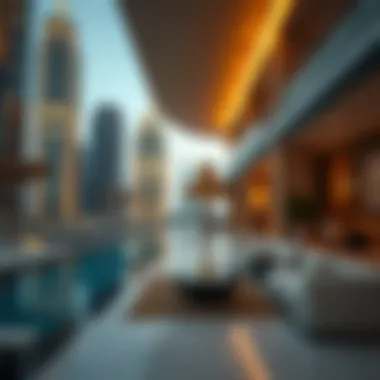

- Social Cohesion: Events unite people from diverse backgrounds, creating bonds and fostering community spirit.
- Economic Boost: With increased foot traffic, local businesses thrive during festivals, enhancing the overall economic landscape.
- Cultural Education: Such events provide a platform for various cultural expressions, educating attendees about different ways of life.
Neighborhood Highlights and Real Estate Insights
Understanding the neighborhoods of Dubai is fundamental for anyone looking to dive into its real estate market. Each area offers a unique flavor that contributes not only to the city’s vibrancy but also to its overall appeal. Investors, expats, agents, managers, and buyers alike gain valuable insights that can sway their decisions in this bustling metropolis.
Overview of Must-See Areas
Downtown Dubai
Downtown Dubai stands as a beacon of modern urban planning and luxurious living. It is home to the iconic Burj Khalifa, the tallest building in the world, which immediately grabs the attention of any visitor. More than just an architectural marvel, it symbolizes Dubai’s ambitions to be at the forefront of global cities.
One of the main characteristics of Downtown Dubai is its walkability. A pedestrian-friendly atmosphere makes it easy for residents and tourists to explore its many shopping centers, parks, and dining options with ease. This area attracts buyers who desire a lifestyle filled with accessibility and luxury amenities.
However, high demand comes with a price. Property values tend to be on the higher end, which can pose challenges for first-time buyers. The high-end lifestyle and the proximity to key cultural attractions certainly make it worthwhile, though.
Dubai Marina
Dubai Marina is another area that cannot be overlooked. This vibrant waterfront community is celebrated for its stunning skyline and luxurious living spaces. What sets the Marina apart is the stunning views and the lifestyle that comes with it, featuring upscale restaurants, cafes, and leisure activities right at your doorstep.
The main highlight of Dubai Marina is the Marina Walk, a picturesque promenade lined with palm trees, making for a lovely stroll or jog. This area is particularly popular among young professionals and families due to its dynamic environment and social scene.
Yet, like Downtown Dubai, the area can be pricey, especially for waterfront properties. The advantage of living in Dubai Marina, however, is the vibrant community life and endless entertainment options available, which often outweigh the costs for many residents.
Old Dubai
Old Dubai, in stark contrast to its modern counterparts, offers a glimpse into the tradition and history that shaped the city. It is characterized by the cultural heritage that is reflected in its markets, traditional buildings, and historic districts like Al Fahidi. The bustling souks, particularly the spice and gold souks, attract numerous visitors, providing a sensory overload of colors, sounds, and smells.
One key characteristic of Old Dubai is its affordability. Real estate here is generally more accessible with lower property prices, appealing to investors looking to enter the market without breaking the bank. It presents a unique opportunity for those who appreciate a blend of old and new as many developments have maintained the traditional architecture while integrating modern conveniences.
Nevertheless, some might find the lack of luxury amenities and the more touristy feel of Old Dubai to be disadvantageous. However, the charm and cultural richness definitely make it a worthwhile place for many expatriates and locals alike.
Market Trends and Investments
The real estate market in Dubai is continually evolving, influenced by local and global trends. With a diverse array of options, investors must stay informed to make sound decisions.
Factors to consider include:
- Property types: From luxury apartments to commercial spaces, the market caters to various investor whims.
- Regulatory environment: Keeping up with changes in laws can benefit savvy investors.
- Economic outlook: Understanding the economic backdrop can influence buying opportunities and timing.
Knowing the landscape is half the battle.
Future Prospects of Dubai's Cityscape
Dubai’s future isn’t just bright; it’s a splendid tapestry woven with threads of innovation and sustainable practices. Understanding the future prospects of Dubai's cityscape is crucial for anyone with a stake in the region. Investors, expats, real estate agents, and other stakeholders need to grasp the emerging trends that will shape the skyline and urban experience in the decades to come.
Focusing on how Dubai plans to balance bold growth with environmental responsibility is at the heart of this exploration. As the city evolves, knowing the specific elements driving this change can enlighten decision-making processes, ensuring alignment with the region's development goals.
Sustainability in Urban Development
Sustainability isn’t merely a buzzword; it’s a guiding principle shaping Dubai's future. Urban projects are now evaluated not just on economic merit, but on their ecological footprints. This shift is significant, especially in a city known for its opulence.
Key elements of sustainability in Dubai's urban development include:
- Green Buildings: Many new developments prioritize eco-friendly designs. The incorporation of energy-efficient systems, sustainable materials, and waste-reduction technologies are increasingly common. This contributes to reduced utility costs and environmental impact.
- Smart City Initiatives: Projects like the Dubai Smart City aim to leverage technology for better resource management. Integrating IoT solutions enhances urban living standards while reducing waste and improving efficiency.
- Public Transport: A robust public transport system is crucial. TransLink Dubai intends to expand metro services, thereby promoting more sustainable mobility throughout the city.
The pursuit of sustainability in projects such as The Sustainable City showcases Dubai’s commitment to the environment. These initiatives are seen as necessary steps toward achieving Vision 2040, where striking a balance between luxury and sustainability is paramount.
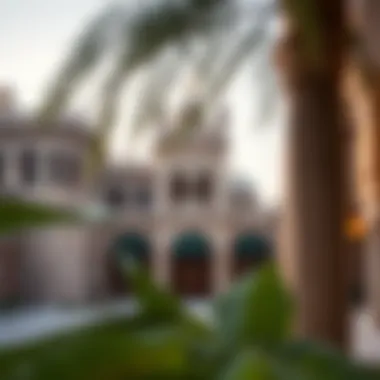

Vision for and Beyond
Vision 2040 is not mere rhetoric; it is a comprehensive roadmap for Dubai's future. Launched by the Dubai government, it aims to enhance the quality of life for citizens and residents while elevating Dubai’s position as a global hub.
Major features of this vision include:
- Urban Development Zones: The city will expand with designated areas focusing on residential, commercial, and tourism developments. This structured growth will help manage resources more effectively.
- Cultural & Heritage Integration: By preserving historical sites while constructing new architectural marvels, Dubai aims to retain its rich heritage amid modernity. The vision incorporates the essence of traditional Dubai into its future developments.
- Community Wellbeing: Creating neighborhoods that prioritize access to parks, schools, and healthcare facilities ensures that the city’s growth benefits all its residents.
“Dubai reflects a journey where the past meets the future—creating spaces that honor heritage while fostering innovation.”
As investors, expats, and community members keep a close eye on these prospects, understanding the interconnectedness of sustainability and ambitious urban development enables them to navigate and invest wisely in this evolving landscape.
Navigating the Real Estate Landscape
Navigating the real estate landscape in Dubai is akin to sailing through uncharted waters, where both challenges and opportunities abound. As a city that’s a blend of tradition and innovation, understanding Dubai's real estate market is essential for prospective buyers, investors, and expatriates. The rapid evolution of its skyline is only paralleled by the dynamic nature of its property market. This section will unpack the vital aspects of property investment and offer insights for making informed decisions in this vibrant landscape.
Essentials of Property Investment
Investing in property in Dubai can be a rewarding endeavor, but it does necessitate a keen eye for detail and knowledge of the local market. First and foremost, it’s imperative to be aware of the various types of properties available. From luxurious villas in Arabian Ranches to contemporary apartments in Downtown Dubai, the choices are as diverse as the city's population.
Key considerations when investing include:
- Legal Framework: Understanding the regulations that govern property transactions is paramount. Foreigners can own freehold properties in designated areas, but it is wise to consult with legal advisors to navigate these waters smoothly.
- Market Trends: Keep an eye on fluctuations in market prices and rental yields. Platforms like Property Finder or Dubizzle can provide insights into current trends.
- Location: As the famous saying goes, "location, location, location." Prime areas may command higher prices, but they often offer better returns on investment due to demand.
- Developer Reputation: Investing in properties developed by reputable firms can mitigate risks associated with unfinished projects. Research the track record of developers to ensure your investment is sound.
Diving into property investment in Dubai without the right knowledge can be akin to running blind. Thus, a thorough understanding and strategic planning can lead to fruitful outcomes.
Choosing the Right Property
When it comes to choosing the right property, one must approach the decision with both heart and head. Properties here are not merely structures; they are reflections of lifestyle and aspirations.
Consider the following factors in your decision-making process:
- Purpose of Purchase: Are you looking for a home, or is this an investment property? Knowing your end goal can influence the type of property you should target.
- Amenities and Services: Prospective buyers should closely evaluate what amenities come with the property. Proximity to schools, healthcare, and recreational facilities can significantly enhance living standards.
- Resale Value: Even if you’re buying the property to live in, consider its resale value. Properties in desirable neighborhoods tend to appreciate over time.
- Community Vibe: Visit neighborhoods to get a feel for the community. Different areas have varying atmospheres, and finding one that aligns with your lifestyle is crucial.
Flexibility in your criteria can sometimes lead to unexpected and delightful finds. As the saying goes, sometimes the best lay in wait.
"In Dubai's real estate market, it’s essential to keep an open mind. The right property can turn out to be one you least expected."
Navigating the real estate landscape in Dubai requires not just investment knowledge but also an understanding of what each area can offer. Familiarizing yourself with the market can lead to making decisions that resonate long after the ink dries on the contract.
End: The Ever-Evolving Dubai Skyline
The landscape of Dubai stands as a testament to human ingenuity, a city that seems to reinvent itself with every passing year. This section aims to distill the essence of what makes Dubai’s skyline not just a collection of buildings, but a dynamic tapestry reflective of culture, ambition, and the relentless march of progress. Understanding this evolution is crucial for various stakeholders, including investors, expatriates, real estate agents, and potential buyers.
Reflecting on the Journey of a City
As one gazes upon the towering structures of Dubai, it becomes clear that each building tells a story. From the humble beginnings as a fishing village to a glamorous metropolis, the transformation has been nothing short of remarkable. The city did not just grow; it flourished against all odds, blending tradition and modernity seamlessly.
Key points to consider from this journey include the following:
- Historical Roots: Elements of the past linger in the form of traditional souks and historical landmarks, reminding residents and visitors alike of where the city began.
- Cultural Significance: Each skyscraper represents not just architectural prowess, but also the aspirations of the people who inhabit this space.
- Economic Drivers: The real estate market benefits tremendously from this rich history, drawing in investments from all corners of the globe.
Reflecting on this journey emphasizes the importance of understanding both the past and present as they relate to future developments. The city continues to expand, driven by dreams and ambitions, leading us towards a skyline that is constantly maturing.
The City as a Living Artwork
Dubai’s skyline can quite fittingly be described as a canvas of architectural art. Each structure, a brushstroke in a larger picture. This metaphorical masterpiece changes and grows, exhibiting both individual creativity and collective vision.
Several aspects add to this artistry:
- Innovative Designs: Architects from around the world contribute unique aesthetics, contributing to an eclectic mix that feels both contemporary and visionary.
- Symbolic Structures: Buildings like the Burj Khalifa or the Dubai Frame aren’t just regional landmarks; they symbolize resilience, ambition, and a forward-looking attitude of a nation.
- Integration of Technology: Smart city initiatives enhance the livability and functionality of the urban space, further cementing Dubai as a pioneer in urban design.
“Dubai is a city that fascinates through relentless evolution, each structure a testament to the spirit of innovation.”






